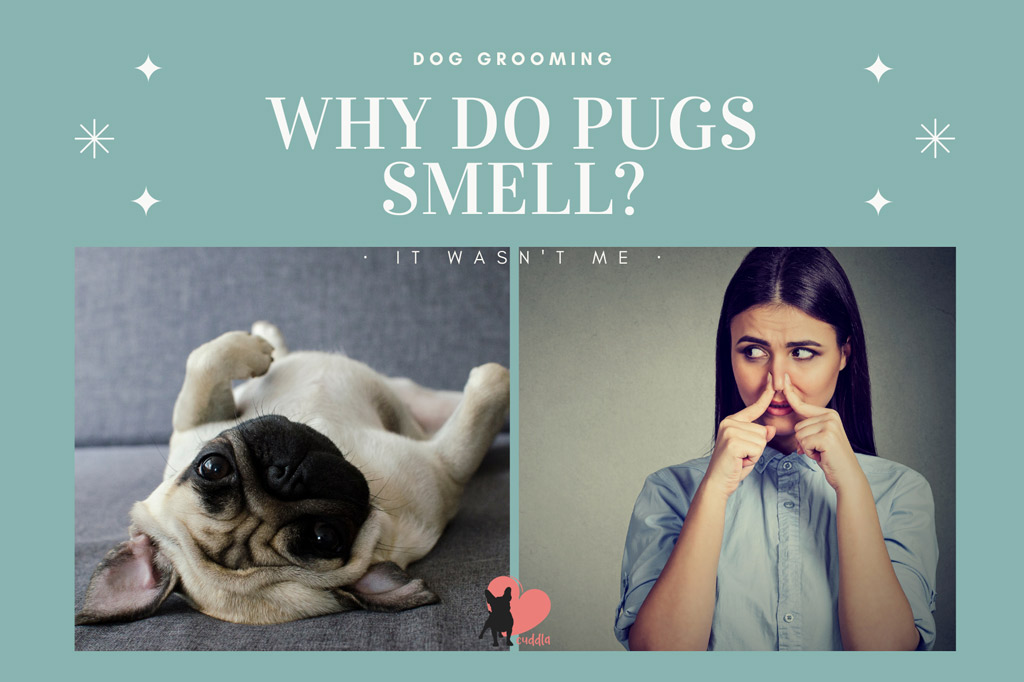
Pugs are smelly, and that’s natural. But, when their body smell gets out of hand, then there is an underlying cause. So, why do Pugs smell so much?
Ear, skin wrinkles, and oral infections are one of the most common causes of Pug’s bad smell. Next is anal glands. Your Pug’s paws can also smell. Also, female Pugs in heat can smell more than usual.
Let’s take a look at the most common causes behind bad odour in Pugs.
Why Do Pugs Smell So Much?
Pugs are one of the top 10 stinkiest dog breeds, along with the English Bulldog, the Boxer, the Beagle, The Yorkie… (I can also vouch for the last one)!
Pugs are renowned for extreme gassiness due to their flat faces (a Brachycephalic trait) and inappropriate diet.
But, why are pugs smelly?
It’s highly probable that your Pug has an infection. The ears, skin wrinkles, and mouth are top areas to check when your dog smells really bad.
Next is anal glands and the paws. Also, when Pugs are in heat, they smell.
Finally, if the whole body smells, it could be a simple case of…
When was the last time you bathe your Pug?
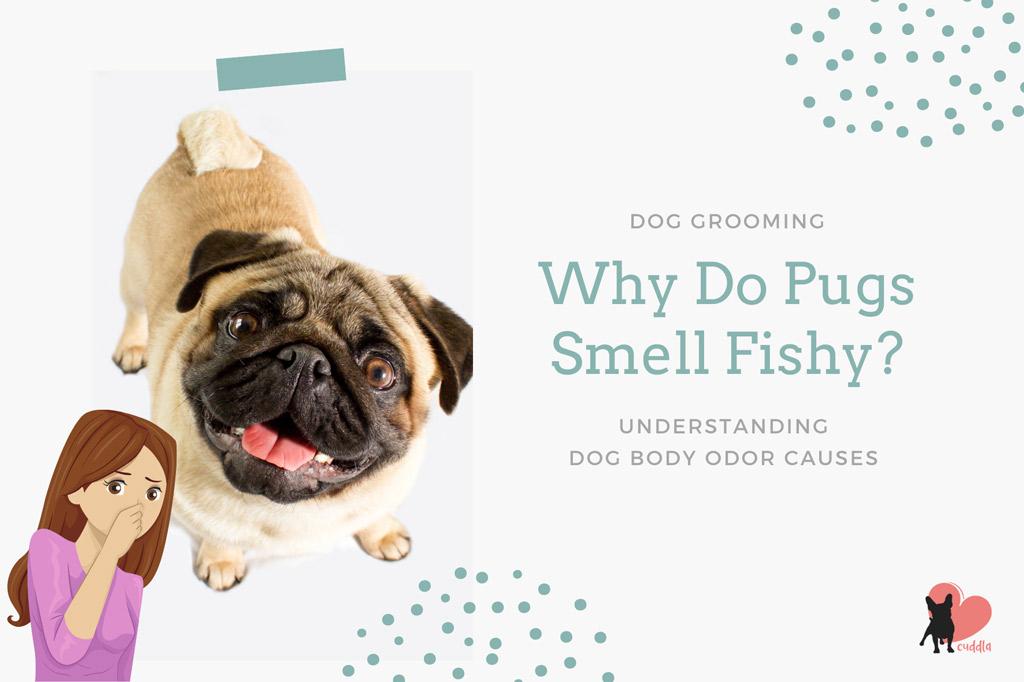
There is a reason behind bad odour in Pugs. Here a 7 of the most common causes:
#1 – Wrinkles
Wrinkles are a brachycephalic breed trait, which can be more pronounced if your Pug is overweight.
These face wrinkles and body skin folds are the most common source of bad smell in Pugs. This bad odour is a sign of Skin Fold Dermatitis, AKA intertrigo, an inflammation of the skin folds.
This condition occurs due to the moisture and heat that builds up in the folds of skin. These make wrinkles a breeding ground for bacteria, yeast, and fungi that would cause infection if not cared for correctly.
Also, skin folds can accumulate dirt and other substances (like food), making your dog itchy.
Apart from the bad smell, your Pug will probably paw at his face or rub it against something (like the sofa or the carpet).
#2 – Mouth
Another source of bad smell, more precisely bad breath, can be the mouth.
Bad breath is a warning sign of dental problems in Pugs, including periodontal disease (infection of the gums and roots of the teeth) and halitosis (bad breath).
Other signs to look out for are:
- Excessive drooling.
- Swollen or bleeding gums.
- Loose or missing teeth.
- Excessive tartar build-up (you are not able to clean it).
If you notice any of these symptoms, pay a visit to your vet.
According to the American Veterinary Dental Society, over 80% of dogs have some kind of dental issue by age 3. As a result, these dogs will very likely have some early evidence of periodontal disease.
It starts with plaque that hardens into tartar and progresses to infection of the gums and roots of the teeth.
If left untreated, your Pug can lose his teeth and be in danger of damaging his kidneys, liver, and heart muscles.
#3 – Ears
The ears could also be the cause of the bad smell, especially if your Pug has an ear infection. A warm, dark and moist environment in your dog’s ear creates the ideal conditions for yeast and bacteria to grow.
The infection of the external ear canal, called “Otitis Externa” (outer ear infection), is one of the most common types of infections in dogs.
Ear infections can be painful, and severe infections may even impact a Pug’s ability to hear. They can develop in one or both ears, so it’s vital to check both ears for signs of infection.
The most common signs of ear infection are:
- Redness.
- Itchiness (your dog shakes his head and scratches his ears) – this is something I have noticed with most of my dogs.
- Off-colour discharge: black or yellowish (not brown wax).
- Swelling or inflammation (ears are hot to the touch).
- Odour.
- Pain when the ears are touched.
You may also notice that your Pug is scratching and rubbing the ears and head if something is bothering him.
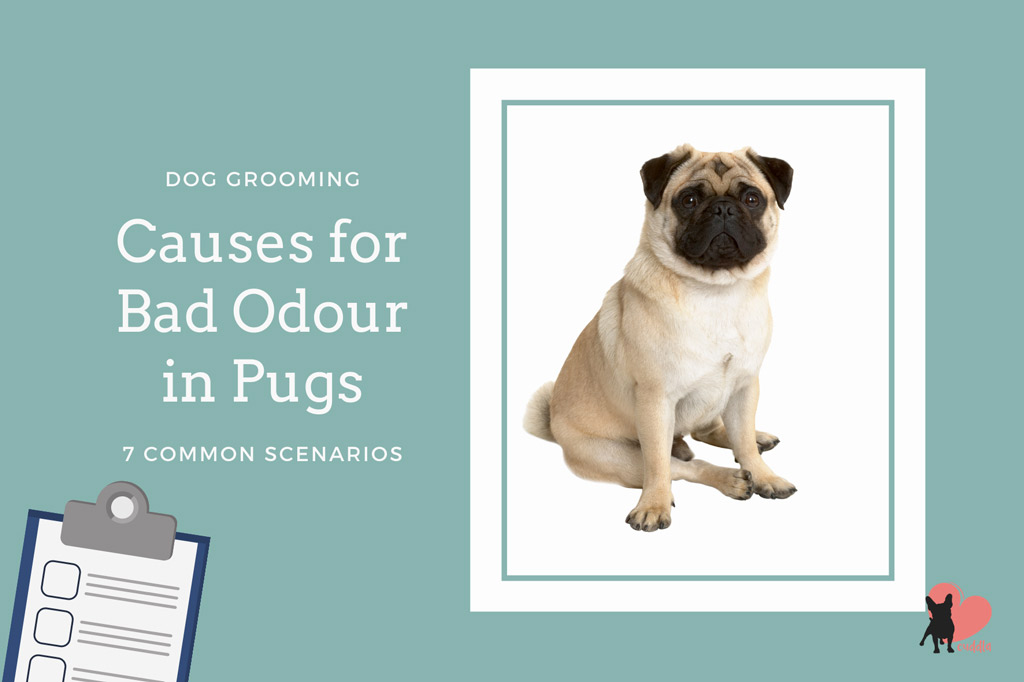
#4 – Anal Glands
Talking about your Pug’s butt can get uncomfortable… But if you own a Pug, chances are that you face your Pug’s butt more than you would like to.
Due to those curly tails, a Pug’s anus is always on display. The fact is that Pugs are known to have anal gland issues that cause a foul odour. This problem aggravates if your Pug is overweight.
The main causes are:
- Secreting more scent oil.
- Feces attached to hair.
- Anal glands leaking or expressing.
Some Pugs simply smell very bad (worse than what’s natural) after pushing out a stool. This is because some Pugs have anal glands that secrete more scent oil than normal.
Another poop-related issue is that…
When stools are not firm, small bits of faeces can cling to the fine hairs around the anus. This can cause a Pug to smell like poop long after their potty break.
Anal glands can occasionally leak or express. Pug puppies and senior Pugs often have weaker muscles in their sphincter and suffer from this problem.
Occasionally anal glands can become impacted or clogged, which causes the famous butt-dragging across the floor and can also lead to infection.
If your dog suffers from any of these issues, take him to the vet.
#5 – Paws
You may not realize it, but your Pug’s paws pick up all kinds of allergens, chemicals and other pollutants, and these build up quickly in their paw pads.
All these harmful pollutants picked by the paws can become extremely irritating to your Pug’s paw pads.
However, your Pug’s paw odour is due to a yeast infection. Since the areas between the paw pads are dark and warm, it makes the paws an ideal place for yeast growth.
Apart from a bad smell, other signs include:
- Itchiness.
- Paw licking.
- Red, inflamed or irritated skin on the pads or between the paw pads.
#6 – Entire Body
Sometimes your Pug’s entire body smells due to two reasons:
- When body oils accumulate and your Pug hasn’t had a bath in a while.
- If your Pug gets wet when it’s raining – commonly known as a “wet dog smell” .
A dog’s body is constantly producing body oils that are expelled through hair follicles. This is a natural way for your dog’s body to keep the skin moisturized.
Since the oils don’t evaporate, over time these oils accumulate and the buildup causes the bad smell.
Lur, my parents Yorkie, smells terrible if he gets wet from the rain, no matter if he had a bathe the previous day!
#7 – Smell During Heat
When female Pugs are in heat, their body smell increases due to the mixture of blood, endometrial tissue and watery body fluids.
While blood doesn’t smell much, when it dries, it can become smellier. Also, the endometrial tissue can also start to emit a stinky smell when dry and crusted around the genital area.
While this is a natural smell to expect from female dogs in heat, and usually not a predominant smell, some dog owners notice it more than others.

7 Tips to Stop Bad Odour in Dogs
Now it’s time to look at the remedies and prevention methods.
How do I stop my Pug from smelling?
Regular grooming is essential to prevent bad odours and keep your Pug healthy.
Depending on the cause of the smell, choose the tip that’s right for your pooch. However, all of them contribute to a healthy well-groomed Pug!
Note: Always consult a vet if you suspect that your Pug has an infection. This way you will get the appropriate treatment for your dog’s condition.

#1 – Clean The Face and Body Wrinkles
To avoid skin infections and bad smell, clean your Pug’s wrinkles daily and keep the area free of moisture.
You could also do it twice a day: in the morning and at night. I think it depends on how deep your dog’s wrinkles are and how dirty they get!
Use a soft damp cloth or dog grooming wipes to wipe between your Pug’s wrinkles.
I refer to them as “dog grooming wipes” because a lot of commercial wipes have many harsh chemicals that are not only harmful to us, but also to our dogs!
These dog face wipes (available in Amazon) are free of alcohol, parabens and harsh chemicals. Plus, they have antibacterial properties!
This wrinkle routine removes any lingering food particles, dirt, and moisture (like skin oils) between your Pug’s skin folds, keeping the folds clean and dry.
Be gentle when you clean the skin folds to avoid irritating your Pug’s skin.
After drying his skin folds gently but thoroughly, moisturize his skin with a bit of coconut oil.
There are many reasons why coconut oil benefits your pooch:
- Skin health: It improves skin health and clears up conditions like flea allergies, eczema, itchy skin, and contact dermatitis.
- Antimicrobial properties: It has antifungal and antibacterial properties as well. That’s why it helps heal and relieve cuts, hot spots, wounds, stings, and bites.
- Infection prevention properties: It helps prevents yeast infections, particularly candida.
- Skin moisturizer: This oil is also a rich source of lauric acid. It moisturizes dry skin and gives your dog’s coat a shiny gleam.
- Odour reduction: It reduces doggy odour when applied to their skin; plus doggy breath when used as part of dental treatment.
Finally, switching to a lower carbohydrate food or totally avoiding them helps.
High carbohydrate foods encourage bacteria and yeast growth throughout your dog’s body – they (the bacteria) feed off carbohydrates.
Insider Tip: Also, it helps to stay away from oatmeal shampoos as they contain carbohydrates that will only feed the bacteria on the skin.
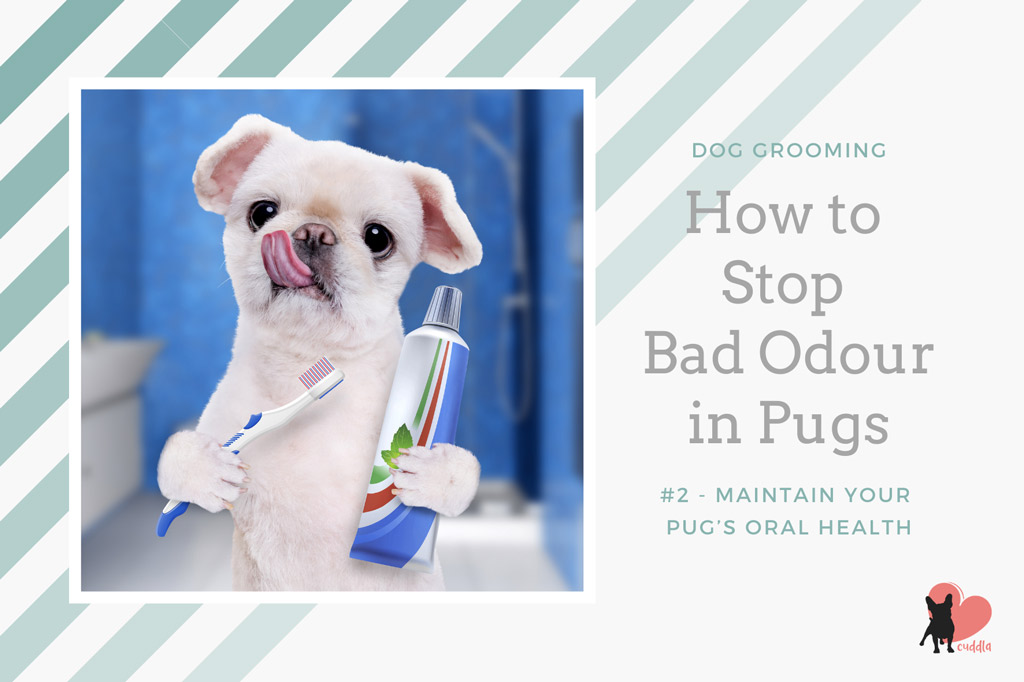
#2 – Maintain Your Pug’s Oral Health
Brushing your Pug’s teeth is probably the most effective way to prevent dental disease, bad breath and tooth decay.
Ideally, you want to brush your Pug’s teeth every night, or at least two times a week. Dogs with dental problems may need more frequent dental care. So, check with your vet to determine the best practice for your pooch.
What do you need?
- Canine toothbrush:
- Option 1: A dog toothbrush is similar to human toothbrushes, but are smaller and have much softer bristles. They also are dual-headed, which makes it easier to reach certain areas. Alternatively, you can use a child’s soft toothbrush.
- Option 2: A dog finger toothbrush, which fits over your finger and makes cleaning those hard-to-reach areas easier.
- Canine toothpaste:
- Option 1: Commercial dog toothpaste (available in Amazon) comes in several flavours such as poultry and beef. Check their ingredients for the most natural option.
- Option 2: For a homemade alternative to clean your dog’s mouth without “toothpaste”, you can instead use raw coconut oil (in solid form and cooking graded). This is a wonderful option to keep your dog’s teeth and gums clean and free from the formation of plaque and bacteria.
Insider Tip: Most human toothpastes contain fluoride, which is extremely toxic—and sometimes fatal—to dogs. So always go for or use a dog-friendly toothpaste.
Chewing is a great way to promote oral health.
Dog chew toys are not only great to keep your Pug busy, but also help promote healthy teeth and gums.
Here are some examples:
- Chew toys: There are tons of indestructible chew toys out there (like Nylabone Flavored Bone – Amazon link). They are made with tough but safe rubber that will keep your dog away from chewing anything else!
- Rubber dental chews: A rubber dental chew is made specifically to clean your dog’s teeth. The chewing action scrapes off plaque and tartar.
- Eatable dental chews: There’s a wide selection of dental chews available in Amazon. These are filled with ingredients (like enzymes) to help prevent further build-up and make your dog’s breath fresher. However, have a look at the ingredients list since some contain questionable ingredients.

#3 – Clean Both Ears
As a guideline, you can clean your Pug’s ears every two weeks or every month, depending on how dirty they get or how much wax your dog produces.
Cleaning your Pug’s ears regularly will avoid odour, wax build-up and also prevent ear infections from developing.
For instance, if you bath your pooch every month, it’s best to clean his ears afterwards.
Also, if your pup spends a lot of time in the water or swimming, you should clean his ears afterwards to clear out excess moisture.
What you need is:
- Ear cleaner: There’s a wide variety of ear cleaners. You can either go for a homemade solution like water and vinegar mix (very diluted solution to reduce the sting) or get an alcohol free ear cleaner.
- Cotton balls or pads: These are great to wipe away the product excess and discharge, and to dry the ear canals once they are clean.
- Ear powder: Ears can get itchy (but not red) and/or dry after being cleaned. That’s why you might want to consider purchasing a talc-free baby powder or use some natural oil such as coconut oil (Amazon links).
To learn how to clean your dog’s ears, read this article.
#4 – Keep The Anal Glands Clean
If your Pug suffers from anal gland issues, speak to a vet to discuss the best course of action.
As part of a grooming routine, keep your Pug’s anal glands clean by wiping them when neccessary.
You can use these dog wipes since they are free of alcohol, parabens and harsh chemicals.
Do Pugs need their glands expressed?
If you don’t feel comfortable handling this stinky area, you can take your Pug to a groomer to express the glands.
A word of caution: While many groomers are trained to do the expression, doing it wrong can lead to further anal gland problems. So, if you have any concerns, talk to your vet.
#5 – Clean The Paws Regularly
Cleaning your Pug’s paws regularly eliminates bad smell, prevents yeast infection and avoids irritation from harmful pollutants.
Plus, it will reduce the amount of time your Pug spends licking and chewing at his feet.
Paw soaks work better at the end of the day since you won’t be taking your Pug for a walk.
If you don’t have time for a soak, you can use dog wipes instead, since these also have antibacterial properties.
For a step by step guide on how to soak your dog’s paws, check this blog post.
#6 – Bathe When Necessary
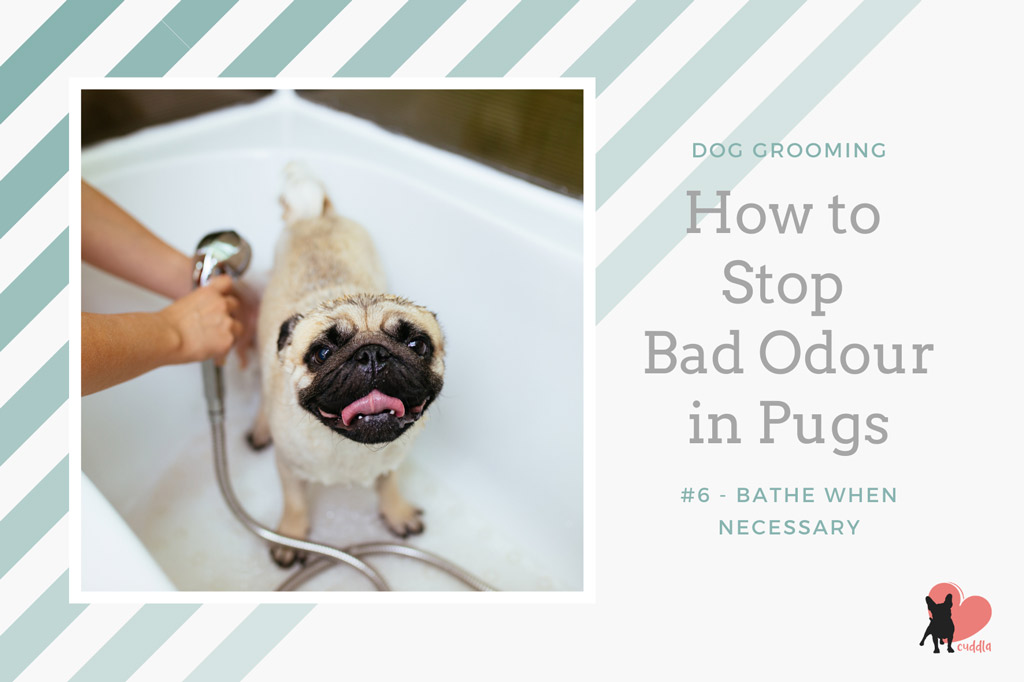
All over body odour on a Pug can usually be fixed by a bath.
But, how often should I bathe my Pug?
Pugs need a bath when they are dirty, itchy or stinky. On average, you can bathe your Pug every 4, 6 or 8 weeks.
Insider Tip: Frequent bathing strips the natural oils out of their skin and dogs need those oils in their fur to keep their coats and skin healthy.
How often you bathe your Pug will depend on factors like:
- Outdoor time: How much time does your Pug spend outdoors? Some love to get dirty (jumping into mud puddles and rolling in the dirt). However, if the soil is dusty or wet, your dog’s paws, legs and belly are bound to get dirty when going for a walk.
- Age: Puppies don’t need to have a bath until they are 3 months old.
- Skin conditions: If your Pug has any allergies or other skin conditions, this will also affect how often he will get a bath. Check with your vet for a more specific approach to his bathing routine.
Here are the basics things you need:
- A bathing space: Kitchen sink, laundry tub, walk-in shower, regular bathtub… Or my prefered place, a small foldable pool in the garden (I got mine in Amazon).
- A big enough towel: I have a reserved towel that I use to dry my doggie.
- Shampoo for dogs: The type of shampoo you use will depend on your dog’s needs as well as your personal preferences.
- Conditioner for dogs: I don’t use dog conditioner. However, I rub some coconut oil on the dog’s skin after he’s dry. It’s great to avoid dry and itchy skin!
- A rubber brush: I like using a rubber brush (available in Amazon) to brush him before the bath, to get rid of dead hairs and dirt, and also afterwards, to remove the excess of water.
For how to bathe your dog, step by step, click here. This blog post also includes harmful ingredients to avoid when choosing your dog’s shampoo!

#7 – Maintain Your Dog’s Hygiene During Heat
Whilst your female Pug is in heat, you can give her partial or full baths if necessary to reduce the smell and keep her genitals clean.
Also, you can change her dog diapers more frequently in order to decrease the smell.
Depending on how heavy the flow is, a new diaper may need to be changed every 4 to 12 hours.
P.S. For more about grooming your Pug, check our Dog Grooming At Home Tips: The Ultimate Guide.
